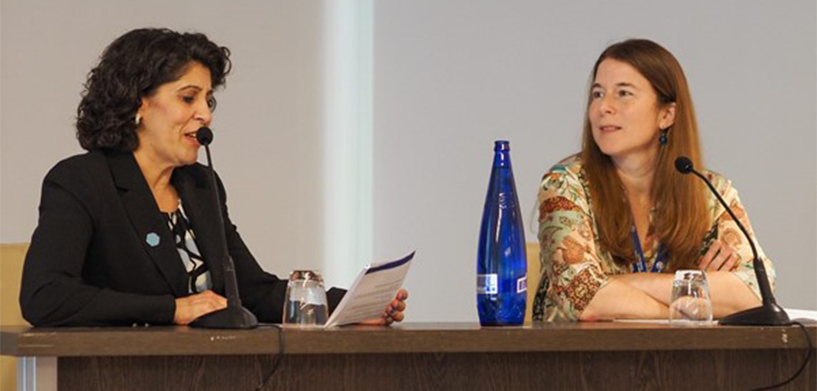Last June, Hexagon participated in OGC’s 123rd Member Meeting in Madrid, Spain. Besides connecting location, showing why standards matter, and sharing how interoperable technologies like scalable cloud, AI/ML, and more are the future of geospatial, there was also time for a fireside chat between two leading geospatial ladies: OGC CEO Nadine Alameh and Sofie Haesevoets, Hexagon’s Senior Product Manager for the Luciad portfolio. The fireside chat was part of the ”Women in Geospatial” focus of the meeting.
A history of innovation
After obtaining a Ph.D. in Computer Science, Sofie joined Luciad (now part of Hexagon) in 2005. After holding several positions in consultancy services, product training and pre-sales, she moved to product management in 2014. From that unique position, Sofie keeps a finger on the pulse of needs and trends both from industry and from within Hexagon.
When Sofie joined the product management team, the Luciad portfolio had already existed for many years. This gave her the opportunity to work on important evolutions of the products based on new technologies, such as 3D and hardware acceleration for the web, a re-architecture of our server solution to prepare for cloud and distributed deployment, and, more recently, a new mobile solution for Android devices.
The latter was mentioned by Sofie as one of the coolest products she has worked on. Traditionally, the mobile part of a system offers reduced applications, but today phones and tablets have become powerful devices with graphics processors and with high-resolution screens. This allows us to create a mobile solution supporting 3D and rich visuals, on par with what you would see on desktop or web applications.
Creating digital realities
Asked for her all-time favourite feature, Sofie named the support for panoramic imagery that was added to LuciadRIA in October 2020. A panoramic image is a bubble in which you can look around. But today, one type of imagery is not the only source of information as there are 3D structures, city models, aerial imagery and more. Therefore, our team came up with a way to place all the parts of a panoramic image at the right location in a 3D scene. This means that a real-time car track can drive through a street bordered with trees, and you can see it being partly hidden by some of the trees from the panoramic photo, while itself hiding the trees behind it.
When questioned about new challenges ahead, Sofie mentioned digital reality. Evolutions in scanner technology provide more data at better resolution, requiring more processing power. Hexagon’s answer to that was the introduction of HxDR, a cloud-based storage, visualization and collaboration platform for reality capture and geospatial data. It creates accurate visualizations of the world based on combined scans.
Expanded geospatial offerings
Another challenge that Sofie cited was geospatial cloud-based solutions. Serving data and applications off the cloud is possible today, but there are many other geospatial cloud use cases. Investigations are ongoing to see how we can further improve and extend our products to cover those more specific use cases.
When asked if it is easier or harder to sell geospatial products nowadays, Sofie replied that it’s both.
In a broad range of application domains, people are now appreciating the added benefit of geospatial capabilities; that makes it easier to reach out. But once you start looking into the details of a project, you identify challenges. For example, in construction and mining, 3D has been present for a long time. For situational awareness, it is a requirement to add location data, but 3D models are typically not georeferenced. Close collaboration is needed to cover these use cases, solve the challenges and bring the domains closer together.
Automation is the future
As for predicting the next big thing in geospatial, Sofie’s answer is automation. The evolutions in sensors, their precision and portability have led to a huge amount of available data. There are too many inputs, and for now we can only store the information, not see it, understand it, and put it to work. Automation will be key to changing that.
Related to that is edge computing, where, for example, a camera no longer streams video, but stores it locally and only reports on interesting patterns. Drones carrying sensors assist us more and more, but we need to automatically process what they scan, what they should scan, and automate as much as possible the updating of 3D models and digital twins. In this setting, standardization becomes even more important. To integrate all that data, interoperability is key.
Sofie ended the interview with two pieces of advice for women in the industry. First, look for inspiring role models. When she was a young girl, Sofie was inspired by the life story of Marie Curie, a scientist who combined a passion for work and had a family. Second, believe in yourself. As a woman, she said, the most beautiful thing you can wear is confidence!
Are you inspired by Sofie’s story and also pursuing a career in technology? Have a look at our job openings, and don’t hesitate to apply!
















